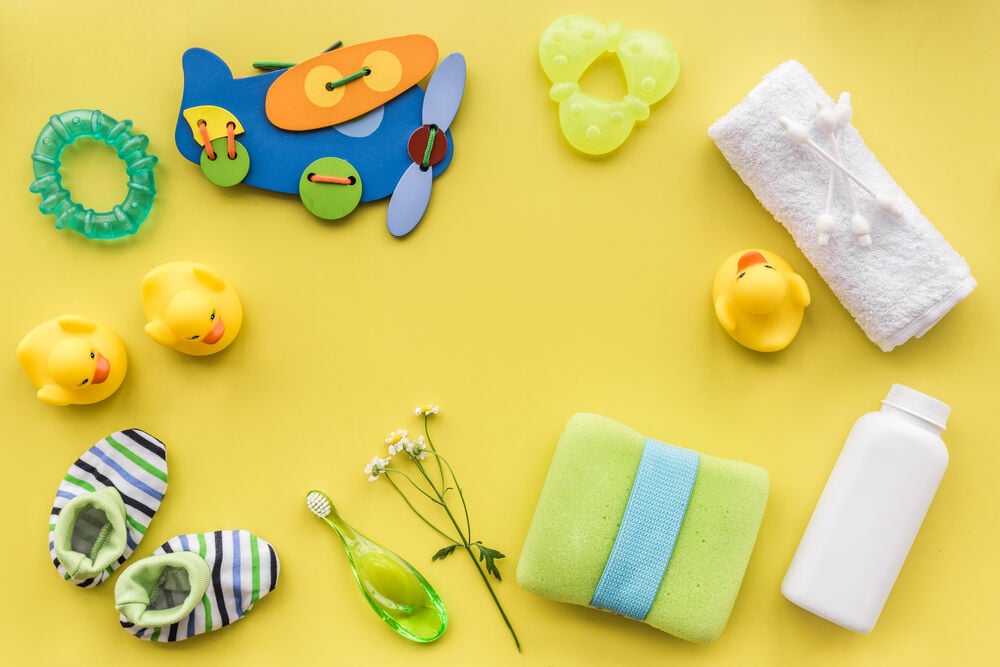Giving a newborn a bath for the first time is an important event, and new parents often have lots of questions about it. Read on to learn all the ins and outs of how to give a newborn a bath.
-
Tracking cycle
-
Getting pregnant
-
Pregnancy
-
Help Center
-
Flo for Partners
-
Anonymous Mode
-
Flo app reviews
-
Flo Premium New
-
Secret Chats New
-
Symptom Checker New
-
Your cycle
-
Health 360°
-
Getting pregnant
-
Pregnancy
-
Being a mom
-
LGBTQ+
-
Quizzes
-
Ovulation calculator
-
hCG calculator
-
Pregnancy test calculator
-
Menstrual cycle calculator
-
Period calculator
-
Implantation calculator
-
Pregnancy weeks to months calculator
-
Pregnancy due date calculator
-
IVF and FET due date calculator
-
Due date calculator by ultrasound
-
Medical Affairs
-
Science & Research
-
Pass It On Project New
-
Privacy Portal
-
Press Center
-
Flo Accuracy
-
Careers
-
Contact Us
How to Bathe a Newborn: A Comprehensive Guide

Every piece of content at Flo Health adheres to the highest editorial standards for language, style, and medical accuracy. To learn what we do to deliver the best health and lifestyle insights to you, check out our content review principles.
When to give newborns a bath and how often
You may start to bathe your baby soon after they are born; however, it’s better to wait until they’re at least 24 hours old. Doctors advise giving your newborn up to three baths per week for reasonable amounts of time. Bathing your baby more frequently than that, especially with soap, may make their skin dry. In between baths, It’s fine to clean their genitals using cotton pads and warm water.
Wondering when to give newborns a bath during the day? You can give a baby a bath at any time. Make sure you have enough time to be attentive and relaxed and limit chances of interruption. For the best possible experience, avoid bathing a baby when they are hungry or immediately after feeding them.
If your newborn likes bathing, a bath can be a relaxing part of their bedtime routine.
Sponge bath: first steps in giving a newborn a bath
For the first few weeks, your baby will need sponge baths. This is a safe way to give a baby a bath before their umbilical cord stump detaches. Before giving your newborn a sponge bath, make sure you have all the things you need for the bath within reach.
Here’s a handy supply list for a newborn sponge bath:
- Towel or a blanket to lay on hard surfaces
- Basin of lukewarm water
- Washcloth
- Clean diaper
- Baby soap (mild)
- Baby towel
Follow these steps to give your baby a sponge bath:
- Choose a warm room for bathing your baby. Use warm, not hot, water. Remove their diaper and clothes and gently wrap the baby in a towel.
- Lay them on a flat surface such as a changing table or bed.
- Unwrap their towel, taking care to expose only the part of their body you’re about to wash.
- Start with the top of their head and face. Dip a clean washcloth in warm water without soap and wipe around their eyes, chin, outer ears, neck folds, and forehead.
- Add a couple of drops of baby soap to the basin and dip the cloth in the soapy water. Use this washcloth to clean the remaining areas of their body one at a time, ending with the diaper area.
- Use a fresh towel to dry your infant, paying special attention to their skin folds.
If your newborn’s penis was circumcised, carefully follow the instructions from your health care provider to keep the area dry and clean. The area will generally heal in a few weeks, depending on the method used.
Bathing in a tub: baby bath water temperature and more
After their umbilical cord stump falls off, you can give a baby a bath in a bathtub. Follow these steps to bathe your infant safely in a bathtub:
Fill the baby tub with a little water. It’s best to use an infant tub manufactured on or after October 2, 2017, so that it meets the most recent safety requirements. You can place the tub in your regular bathtub or sink, depending on the model.
Take a quiz
Find out what you can do with our Health Assistant
After their umbilical cord stump falls off, you can give a baby a bath in a tub.
Start by filling the tub with cold water, then add hot water to bring it to the desired temperature. Generally, two or three inches of warm water in the tub is enough. Always check the baby bath water temperature using your wrist or elbow before placing an infant into the tub. If you have a bath thermometer, the baby bath temperature should be about 100 degrees Fahrenheit.
Undress the baby and immediately put them into the filled bathtub to keep them warm and comfortable.
Using one hand, support the baby’s head. Use the other hand to place them feetfirst into the bathtub. Always keep their neck and head above the water.
Use only mild, pH-neutral baby soap with no additives to give a baby a bath.
Gently pour or splash warm water over the baby to keep them warm in the bathtub.
Use only a little bit of mild, pH-neutral baby soap with no additives. Clean the baby with a washcloth or your hand from head to toe and front to back. To rinse shampoo from their head, cup your hand across the forehead so the suds run toward the sides, not into their eyes. Use a soap-free wet washcloth to clean their face and eyes gently.
Rinse the infant thoroughly using cups of warm water. Wipe them clean with a washcloth. Then, carefully lift them out of the bathtub by supporting their head and neck with one hand and their bottom with the other.
Wrap your infant in a towel and pat them dry, paying special attention to between their skin folds.
While giving a newborn a bath, never leave them unattended in the water for even a second.
Baby bath set: what you need

Depending on your home and lifestyle, you may need certain baby bath products to give a newborn a bath:
- A baby bathtub that meets safety standards: You can place it on the floor while bathing your baby.
- Bath towels for babies: A hooded bath towel will help dry your baby’s hair and body while keeping them warm.
Make sure your baby bathtub is compliant with safety standards. For baby shampoos, choose products that are dermatologically tested, hypoallergenic, and alcohol-free.
- Bath toys for older babies: These help make bath time enjoyable and fun while supporting your baby’s eagerness to develop new skills.
- Shampoo shield: This helps protect your baby’s eyes from shampoo while you wash their hair.
- Baby washcloths: Buy soft washcloths made of pure cotton (100 percent cotton) to protect the baby’s delicate skin.
- Baby shampoo: Baby shampoo is much gentler than shampoo for adults. The best products are dermatologically tested, hypoallergenic, and alcohol-free.
Key takeaways on how to bathe a newborn
Some infants love baths right away, but others find their first baths a little distressing. After a little while, most babies do start enjoying bath time. If your infant cries during baths, make sure the room is comfortably warm and the baby bath water temperature isn’t too hot or cold.


Hey, I'm Anique
I started using Flo app to track my period and ovulation because we wanted to have a baby.


The Flo app helped me learn about my body and spot ovulation signs during our conception journey.


I vividly
remember the day
that we switched
Flo into
Pregnancy Mode — it was
such a special
moment.
Real stories, real results
Learn how the Flo app became an amazing cheerleader for us on our conception journey.




